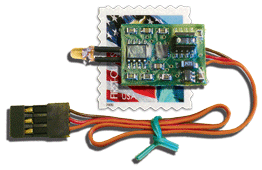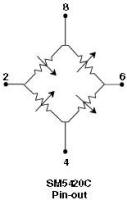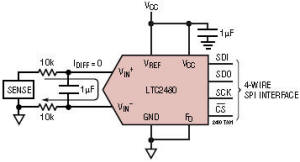|
 Winged Shadow Systems has developed
a solid state electronic altimeter called the
How High™ that plugs into a spare receiver channel for
power, and provides altitude readings between 50 feet and 7,000 feet above ground
level. My How High™ is version 1 that was sold
back in the 2006 - 2007 realm, so that is the one I will be describing here. There
is a version 2 available now with a couple additional functions, like storing the
last altitude reading even after power has been removed. Winged Shadow Systems has developed
a solid state electronic altimeter called the
How High™ that plugs into a spare receiver channel for
power, and provides altitude readings between 50 feet and 7,000 feet above ground
level. My How High™ is version 1 that was sold
back in the 2006 - 2007 realm, so that is the one I will be describing here. There
is a version 2 available now with a couple additional functions, like storing the
last altitude reading even after power has been removed.
Here is a link to the
user's manual that comes with it. See a video with me demonstrating
the How
High's use in my Aquila Spirit glider.
 The heart of the system is
the SM5420 pressure sensor, by Silicon Microstructures. It is a micromachined structure
molded in an 8-pin SOIC plastic package. Here is the
datasheet. Per the manufacturer, "The SM5420C is a small outline
SO-8 packaged pressure sensor. The sensor uses SMI’s SM5108C micromachined, piezoresistive
pressure sensing chip that has been optimized to provide the highest possible accuracy
for a package of this size. This performance is achieved through careful resistor
placement and mechanical configuration along with advanced MEMS processing." The heart of the system is
the SM5420 pressure sensor, by Silicon Microstructures. It is a micromachined structure
molded in an 8-pin SOIC plastic package. Here is the
datasheet. Per the manufacturer, "The SM5420C is a small outline
SO-8 packaged pressure sensor. The sensor uses SMI’s SM5108C micromachined, piezoresistive
pressure sensing chip that has been optimized to provide the highest possible accuracy
for a package of this size. This performance is achieved through careful resistor
placement and mechanical configuration along with advanced MEMS processing."
 The
SM5420 is fundamentally a resistive bridge structure similar to the familiar Whetstone
Bridge, as shown to the left. So, in order for the How High™
to measure altitude, it must obtain and store a reference value when the device
is first powered on. Then, an analog-to-digital converter feeds a custom programmed
IC to store the highest level recorded and display its content using a series of
light pulses from an LED. A stable voltage reference source helps ensure accuracy. The
SM5420 is fundamentally a resistive bridge structure similar to the familiar Whetstone
Bridge, as shown to the left. So, in order for the How High™
to measure altitude, it must obtain and store a reference value when the device
is first powered on. Then, an analog-to-digital converter feeds a custom programmed
IC to store the highest level recorded and display its content using a series of
light pulses from an LED. A stable voltage reference source helps ensure accuracy.
Looking at the circuit assembly to the left, the SM5420 package is in the upper
right corner. Interestingly, it has a U-shaped piece of magnet wire laying on top
of the device and soldered to the lead frame protrusions from the end of the molded
plastic package. My guess is that it either helps protect the circuitry from ESD
discharges, or it somehow helps prevent an electric field from accumulating around
the micromachined structure and disturbing the sensitivity of the measurements.
Surface mount packages are notoriously cryptically marked (due to not much room),
so I have to guess at some of the parts. In the lower right corner is a 5-pin SOT
that is likely the voltage reference.
 In the upper left corner of the
PCA (printed circuit assembly) is a PIC12F683 8-bit microcontroller by Microchip
Technologies. Here is the
datasheet. Since I do not see anything resembling a crystal, I
assume a resistor + capacitor is used for the clock generation. The datasheet allows
for such a scheme (see page 23). The PIC12F683 also contains an analog-to-digital
converter (ADC) and voltage comparator, but there is a separate, more precise IC
used for that - the Linear Technology LTC2480. The designer(s) at Winged Shadow
Systems burns a custom program into the PIC12F683 that performs all the nifty steps
necessary to determine the maximum altitude and to report the number to you, and
even detects the wagging of your finer in front of the LED to activate the report
mode. A diode's transconductance is affected by visible light impinging on its surface,
so it is possible to use it as a light level detector when housed in a transparent
package, so it acts both as an LED for reporting, and as a detector for initiating
the report (very clever idea, I might add). In the upper left corner of the
PCA (printed circuit assembly) is a PIC12F683 8-bit microcontroller by Microchip
Technologies. Here is the
datasheet. Since I do not see anything resembling a crystal, I
assume a resistor + capacitor is used for the clock generation. The datasheet allows
for such a scheme (see page 23). The PIC12F683 also contains an analog-to-digital
converter (ADC) and voltage comparator, but there is a separate, more precise IC
used for that - the Linear Technology LTC2480. The designer(s) at Winged Shadow
Systems burns a custom program into the PIC12F683 that performs all the nifty steps
necessary to determine the maximum altitude and to report the number to you, and
even detects the wagging of your finer in front of the LED to activate the report
mode. A diode's transconductance is affected by visible light impinging on its surface,
so it is possible to use it as a light level detector when housed in a transparent
package, so it acts both as an LED for reporting, and as a detector for initiating
the report (very clever idea, I might add).
 The Linear
Technology LTC2480 (in the center of the PCA) is a 16-Bit ΔΣ analog-to-digital converter
(ADC) in a 10-pin MSOP package (LBJY is the identifying marking on the package).
Here is the
datasheet. The printed circuit board traces run from the SM5420
to Pin 4 and Pin 5, which are the Vin ports. The 4-wire SPI interface connects to
the PIC12F683 controller. The Linear
Technology LTC2480 (in the center of the PCA) is a 16-Bit ΔΣ analog-to-digital converter
(ADC) in a 10-pin MSOP package (LBJY is the identifying marking on the package).
Here is the
datasheet. The printed circuit board traces run from the SM5420
to Pin 4 and Pin 5, which are the Vin ports. The 4-wire SPI interface connects to
the PIC12F683 controller.
I will not even attempt to guess at the details of programming because it is
not important. The important thing is that the designer(s) at Wing Shadow Systems
are to be commended for such a ingenious approach to this great little altimeter.
Who would have imagined such a precise device even a decade ago, before micromachining
of silicon substrates was able to be accomplished in productions quantities? They
now also have a slick little air speed indicator, but I do not have one of those.
If somebody wants to send me one (working or not), I'll be glad to do a reverse
engineering report on it, too.
|